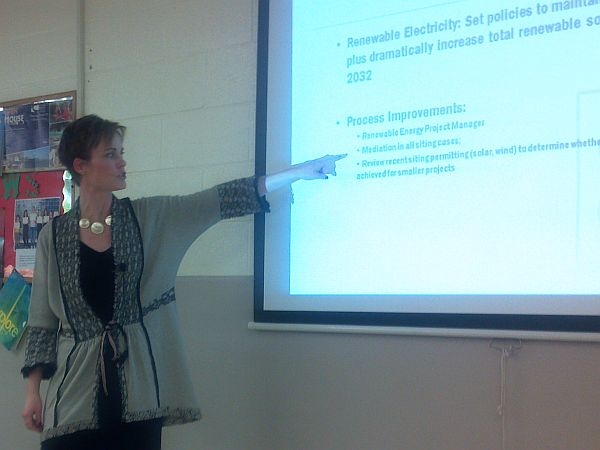
(Host) A new state energy plan calls for a dramatic shift in how Vermonters drive to work and where they get their electricity.
The draft plan sets ambitious goals. It says Vermont should get 90 percent of its energy from renewable sources by mid-century.
As VPR’s John Dillon reports, the Shumlin Administration has taken the plan on the road to gather public reaction.
(Miller) "Okay folks, I’m going to go ahead and get started."
(Dillon) The meeting room last week at the Danville School was full of people at low tables trying to squeeze their adult bodies on to kid-sized stools.
Public Service Commissioner Elizabeth Miller was the teacher for the day.
(Miller) "So where are we now? Just to set the table for discussion: we have about one-third of energy usage in transportation statewide, and just over one third in our homes, and one third in our business."
(Dillon) Miller clicked through a PowerPoint that shows that just 23 percent of the energy Vermonters use for transportation, electricity and heat comes from renewable sources.
The energy plan, the first comprehensive re-write since 1998, sets a bold goal. It puts Vermont on a path to boost renewable use to 90 percent by 2050. But to do that, the state has to step it up considerably.
Miller acknowledged in her talk that Vermont is falling short in two key areas: First, we’re not on track to meet next year’s greenhouse gas reduction targets. And the state is also lagging on a goal to make homes more energy efficient, which would mean less fossil fuel burned for heating.
(Miller) "The legislature has a goal of 80,000 homes improved 25 percent in our energy savings by 2020. And we’re far behind that goal. We would have to significantly increase our pace if we were to hit that legislative goal by 2020."
(Dillon) So how does the plan reverse these trends? It calls for stronger efficiency programs to cut energy use. It envisions new renewable energy projects, and, most dramatically, a sea change in transportation.
(Miller) "It’s important to recognize that we won’t get to a 90 percent renewable mid-century unless transportation transforms."
(Dillon) The transformation means more car-pooling and ride-sharing. It also means a vehicle fleet that runs on electricity from renewable sources such as solar or wind.
But large scale wind development on Vermont’s mountains is controversial, especially in the Northeast Kingdom where one project has been built and another is under construction.
Some of the feedback at the Danville meeting focused on utility scale wind. Ben Luce teaches physics at Lyndon State College. He cited a federal study showing that on-shore wind in the Northeast could supply just 4 percent of the region’s energy needs.
(Luce) "This kind of regional perspective is entirely missing from the comprehensive energy plan and needs to be factored in. What that means is that if we go whole-scale with wind here, we will devastate our ridges but we will not make a significant improvement to reducing greenhouse gas emissions."
(Dillon) Luce says solar power and geo-thermal energy deserve more attention. Others at the Danville meeting said energy transformation starts at home. Nicholas Ecker-Racz lives off the grid in Glover, and he’s challenged wind opponents to consider their own personal energy use.
(Ecker-Racz) "This speaks to the efficiency emphasis. There are people here who are opposed to these wind towers. I said: only thing is on the way over here you picked up a pack of sixes and you left your pick-up running outside the store. And if I go back to your house now I guarantee the TV’s running, you got 14 lights on."
(Dillon) The Danville meeting was the last of the public hearings on the energy plan. People have until November 4th to file written comments.
For VPR News, I’m John Dillon.
NOTE: For more information on the proposed energy plan, click on link below: